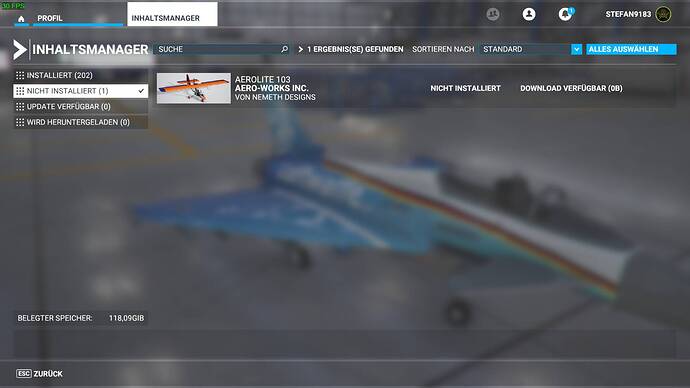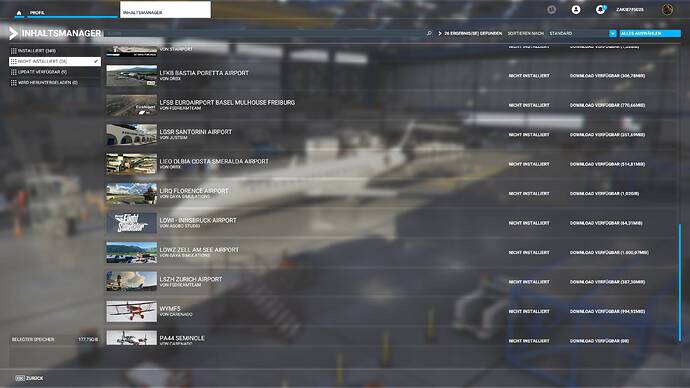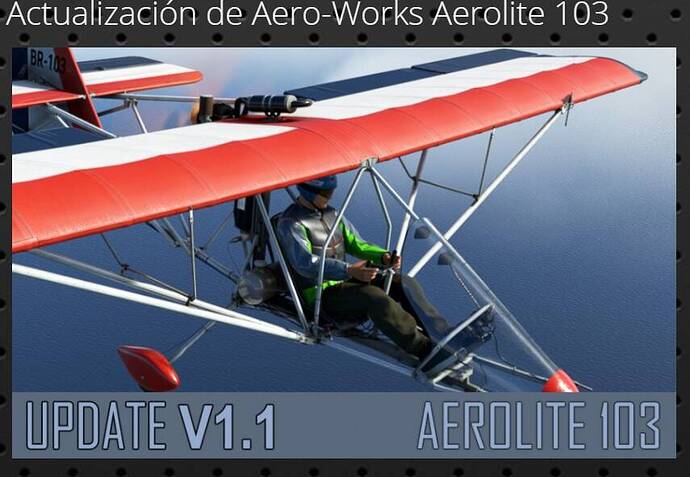I got a similar problem. All addons of the market place are installed but shown as deinstalled.
bought a new plane this morning and cant install it. its downloading and then it wont popup on the hangar. i´m very dissapointed, that i cant play all my bought stuff. need a solution to. btw same to the aerolite103 by me
@Zaki875026
Yes, very disappointing. I paid money for a plane I cant´use 
What does it show in content manager ? This sounds like a Zendesk issue.
@EdamllamaB
Just this after downloading…
My plane ist back!!! 
But I don´t know why…
There have been a few Xbox/MS server issues of late. probably an account/server problem that resolved itself eventually.
Where can I download the updated version as I bought it directly from Nemeth design site ?
I have asked the developer about the update in the MSFS store.
He told me that the latest update is V1.1 and that they always update first in their store.
you lucky guy  my stuff is still not there
my stuff is still not there
I hope your stuff is also back soon 
I realised the version I bought at beginning of March on their site was already the 1.1
Apart from the issues you already commented, I’ve found a new one:
In crosswind operations, the aircraft bahaves the opposite way than it should. For example, if you are landing and the wind comes from your right, the nose will point to the left (The nose should always point to the wind).
It´s really weird. The more I fly this airplane, the more errors I found. It’s a shame because this could be a great aircraft if it worked well.
And the developers don’t plan to fix it? Very dissapointing…
I’m not sure I understand; are you saying that if a crosswind comes from the right, the plane should yaw to the right (into the wind) by itself, and you would have to turn the rudder to the left (away from the wind) to compensate? Wouldn’t this cause the plane to move farther to the left, drifting off the runway?
Yes, that’s what I’m saying, but I don´t know if the term “yaw” is correct in this case, I’ll use slip or drift, but since english is not my native language, I’m not sure.
In crosswind landing conditions you have to apply rudder opposite to the wind direction and the stick to the wind. That’s basic flight theory. Give yourself a try, but don´t use the Aerolite, as it behaves wrong. 
Hmm, so the procedure I would normally follow for a crosswind landing with wind coming from the right (pushing my plane to the left) would be:
- during descent, use rudder to point the plane to the right (turn towards the right, into/against the wind, not towards the left, away from the wind) to keep moving in a straight line with the runway
- at last second before touchdown, apply rudder to the left (away from/with the wind) to point more directly forwards so my wheels are in a straight line with the runway
Am I doing it wrong? 
(I just did my regular procedure in SR-22 on a strong crosswind and it worked as it normally does.)
(I did the same in the Aerolite 103 and it worked as it normally does. Are you sure you didn’t just think the wind was going in the opposite direction from what it was?)
Test procedure:
- Set up flight arriving at Linden, New Jersey (KLDJ) approaching from the east to rwy 27
- Set weather to Overcast preset.
- In sim, change the surface wind layer direction to 0 degrees (from the north, so from the right on approach). Set speed to 15 knots for Aerolite, or 25 knots for SR-22. Set gust direction also to about 0 degrees, and similar speed.
- Do the landing approach. Note the wind coming from the right pushing the aircraft towards the left.
- Use rudder to compensate for leftwards push by turning the nose towards the right.
- Just before touchdown, use rudder to turn the nose towards the left, evening out the wheels for landing.
I don’t see a significant difference between the Aerolite 103 and the Cirrus SR-22’s behavior here; both drift to the left due to the wind and must be turned towards the right manually to compensate. Both require turning the nose back to the left to even out the wheels before touchdown.
Second step right but first step wrong. During the approach, your nose will point towards the wind for the airplane to make a straight line over de ground. At this point, if you apply rudder to the wind, you’ll create an even greater slip angle. What you have to do (Let’s take your test as example) is apply aileron to the right and rudder to de left to mantain runway centerline. This is an uncordinated maneuver that keeps you centered with the runway and you can mantain it till de touchdown.
Please, take a look at this video, it is well explained: https://www.youtube.com/watch?v=zkjENL0uFgI
When I realise the problem with the Aerolite, I was approaching a north heading runway, wind was from de east and when I was flying in a straight line to the runway, the nose were pointed at the left (west). I will do further test, anyway.
So the explanations I’ve seen in the past have listed out two separate ways to do this, either using the rudder (as I’m doing) or the ailerons (as you seem to be doing).
Examples:
In the video, she describes the “weathervane” effect which causes the initial turn into the wind that you described, which I described as explicitly turning into the wind, which you have to compensate for to get going straight aligned with the runway. Is this the bit that you’re seeing an unexpected difference on with the Aerolite 103 then?
I definitely see the behavior I expect when I follow my usual procedure. I’ve never tried not using the rudder and just seeing if the plane happens to turn into the wind. 
(Anyway thanks for the additional tips, I’m learning more!  )
)
There are three methods described, but in reality they are very similar. The diference is when you start to apply rudder to compensate the “weathervane” effect. If you apply rudder early it’s called sideslip, if you do it in the last second before touching is crab and something in between is de-crab. Ok, but you still have to apply aileron to the wind and rudder opposite.
I like to use rudder early, that gives me more feel about the aircraft behaviour.
And the Aerolite behave just de opposite (I’ll do further test).
The weathervane effect actually only occurs when you are on the runway. If you have contact with the ground in an aircraft with a rear tail (pretty much every aircraft in other words) a crosswind will cause the aircraft to weathervane into the wind and in addition will try to lift the wing on the side nearest to the crosswind.
Hence ON THE GROUND in taxi and ground roll you apply aileron into the wind to stop the upwind wing lifting and rudder away from the wind to stop weather-vaning.
Also ON THE GROUND if there is a tail wind it will try and lift your tail so you use back stick and if instead there is headwind it will try and lift your nose so you apply forward stick.
A simple mnemonic often used to work out control positions in high wind is that while ON THE GROUND you should " Climb into the wind, dive away from the wind "
Now for obvious reasons there can be no weather-vaning or tendencies to lift wings or tails when in the air with a constant crosswind, your aircraft just moves through the air with the prevalent wind.
The two common ways to handle crosswind approaches are:
- slip it in so that you both track the centreline and keep the nose pointed at the centreline all the way through approach - this requires use of both rudder and aileron cross controlled to maintain the correct attitude and track throughout the approach. This is done with aileron keeping a wing low so you are continually turning against the wind combined with rudder to keep the nose pointed at the runway . You use aileron to control your left right drift and rudder to keep the nose pointing the correct way. This “wing low” method is the most common way to do it for a single engine GA aircraft. It is a bad way to do it in an airliner as you will risk a pod strike due to the wing low attitude.
- or you can just not really care where the nose is pointing just fly so that the aircraft tracks the centreline and straighten up at the last second before the wheels touch as if you land sideways you may break something important like your landing gear. This crabbing technique basically has the wings level and the aircraft tracking the runway but pointing into the wind. With this method if you set the crab up correctly and the crosswind was constant you potentially would need no aileron or rudder until you flared. Just before touchdown you need to straighten the aircraft to align with the runway. In a light aircraft this is critical as landing sideways is very bad. This method is common for heavies as they do not want to risk a wing low pod strike and also have the inertia to maintain the runway direction even if not perfectly lined up at touchdown.


